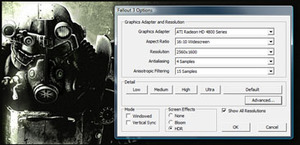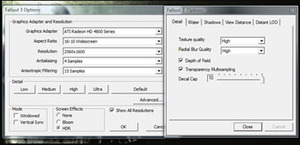XFX ATI Radeon HD 4770 512MB
Written by Antony Leather
May 27, 2009 | 10:57
Tags: #4770 #4850 #4870 #4890 #9800-gtx #evaluation #graphics-card #gts-250 #gtx-275 #performance #radeon #review #rv740

Fallout 3
Publisher: BethesdaFallout 3 is the revival of Interplay’s excellent Fallout series of games following many years out of the limelight. It’s developed and published by Bethesda and, judging by the success of the game, we’ll be seeing more Fallout games in the future.
Despite using the Oblivion engine which is now a few years old, the game looks absolutely stunning. Bethesda has spiced up the graphics a bit since Oblivion and has extended the engine – there are some great explosions, soft shadows and smoke effects that are particularly noteworthy.
We tested the game by manually playing a section of the game that incorporates a number of explosions and effects that you’re likely to experience during your time in post-apocalyptic Washington DC. We recorded the frame rate using FRAPS.
The in-game details were set to their highest values and both anti-aliasing and anisotropic filtering were controlled by the application settings instead of through the driver control panel. This meant that transparency anti-aliasing was enabled, along with HDR and all of the cool smoke effects.
Fallout 3’s engine is by default capped to 60 frames per second, which can make benchmark results very unclear, especially when testing at lower resolutions or with high end graphics cards. To remove the 60fps cap you’ll need to find the Fallout3.ini file in \Documents\My Games\Fallout3 and edit the file so that iPresentInterval=0. This removes the frame rate cap, and allows us to get a much better idea of a card’s abilities.
Fallout 3
1,280 x 1,024 2xAA 16xAF, Maximum Detail
- Nvidia GeForce GTS 250 512MB
- ATI Radeon HD 4850 512MB
- Nvidia GeForce 9800 GT 512MB
- Gigabyte ATI Radeon HD 4770 512MB
- ATI Radeon HD 4770 512MB
- XFX ATI Radeon HD 4770 512MB
- ATI Radeon HD 4830 512MB
- XFX GeForce 9600 GSO XXX Edition 384MB
-
-
70.5
-
42.0
-
-
-
63.3
-
29.0
-
-
-
59.8
-
15.0
-
-
-
57.6
-
26.0
-
-
-
57.3
-
25.0
-
-
-
56.3
-
25.0
-
-
-
53.6
-
26.0
-
-
-
47.0
-
10.0
-
0
10
20
30
40
50
60
70
Frames Per Second
-
Average
-
Minimum
Fallout 3
1,680 x 1,050 4xAA 16xAF, Maximum Detail
- Nvidia GeForce GTS 250 512MB
- ATI Radeon HD 4850 512MB
- Gigabyte ATI Radeon HD 4770 512MB
- ATI Radeon HD 4770 512MB
- XFX ATI Radeon HD 4770 512MB
- Nvidia GeForce 9800 GT 512MB
- ATI Radeon HD 4830 512MB
- XFX GeForce 9600 GSO XXX Edition 384MB
-
-
59.0
-
27.0
-
-
-
50.4
-
22.0
-
-
-
47.9
-
17.0
-
-
-
47.7
-
16.0
-
-
-
47.4
-
18.0
-
-
-
46.8
-
13.0
-
-
-
43.7
-
16.0
-
-
-
22.1
- 1.0
-
0
10
20
30
40
50
60
Frames Per Second
-
Average
-
Minimum
Fallout 3
1,680 x 1,050 8xAA 16xAF, Maximum Detail
- ATI Radeon HD 4850 512MB
- ATI Radeon HD 4830 512MB
- XFX ATI Radeon HD 4770 512MB
- ATI Radeon HD 4770 512MB
- Gigabyte ATI Radeon HD 4770 512MB
- Nvidia GeForce GTS 250 512MB
- Nvidia GeForce 9800 GT 512MB
- XFX GeForce 9600 GSO XXX Edition 384MB
-
-
44.1
-
16.0
-
-
-
40.3
-
14.0
-
-
-
35.8
-
11.0
-
-
-
33.8
-
12.0
-
-
-
33.5
-
11.0
-
-
-
33.0
-
5.0
-
-
-
31.8
-
5.0
-
-
- 3.1
- 1.0
0
10
20
30
40
Frames Per Second
-
Average
-
Minimum
Fallout 3
1,920 x 1,200 4xAA 16xAF, Maximum Detail
- ATI Radeon HD 4850 512MB
- Gigabyte ATI Radeon HD 4770 512MB
- ATI Radeon HD 4770 512MB
- XFX ATI Radeon HD 4770 512MB
- ATI Radeon HD 4830 512MB
- Nvidia GeForce GTS 250 512MB
- Nvidia GeForce 9800 GT 512MB
- XFX GeForce 9600 GSO XXX Edition 384MB
-
-
47.1
-
15.0
-
-
-
43.1
-
14.0
-
-
-
42.8
-
13.0
-
-
-
42.6
-
13.0
-
-
-
40.3
-
14.0
-
-
-
32.1
-
9.0
-
-
-
22.8
- 1.0
-
-
-
17.3
- 1.0
-
0
10
20
30
40
50
Frames Per Second
-
Average
-
Minimum
Fallout 3
1,920 x 1,200 8xAA 16xAF, Maximum Detail
- Gigabyte ATI Radeon HD 4770 512MB
- ATI Radeon HD 4770 512MB
- XFX ATI Radeon HD 4770 512MB
- ATI Radeon HD 4850 512MB
- ATI Radeon HD 4830 512MB
- Nvidia GeForce 9800 GT 512MB
- Nvidia GeForce GTS 250 512MB
- XFX GeForce 9600 GSO XXX Edition 384MB
-
-
34.0
-
5.0
-
-
-
33.2
-
4.0
-
-
-
33.0
-
6.0
-
-
-
32.1
-
4.0
-
-
-
31.8
-
4.0
-
-
-
19.1
- 1.0
-
-
-
18.9
-
5.0
-
-
- 2.0
- 1.0
0
5
10
15
20
25
30
35
Frames Per Second
-
Average
-
Minimum
Fallout 3
2,560 x 1,600 0xAA 16xAF, Maximum Detail
- Nvidia GeForce GTS 250 512MB
- Nvidia GeForce 9800 GT 512MB
- ATI Radeon HD 4850 512MB
- XFX ATI Radeon HD 4770 512MB
- ATI Radeon HD 4830 512MB
- Gigabyte ATI Radeon HD 4770 512MB
- ATI Radeon HD 4770 512MB
- XFX GeForce 9600 GSO XXX Edition 384MB
-
-
56.2
-
27.0
-
-
-
45.2
-
17.0
-
-
-
44.4
-
21.0
-
-
-
41.0
-
16.0
-
-
-
37.8
-
14.0
-
-
-
32.3
-
11.0
-
-
-
32.1
-
11.0
-
-
-
27.2
-
9.0
-
0
10
20
30
40
50
60
Frames Per Second
-
Average
-
Minimum
All the HD 4770s managed playable frame rates at 1,280 x 1,024 2xAA 16xAF with the XFX ATI Radeon HD 4770 512MB managing a minimum of 25fps. The ATI Radeon HD 4830 512MB recorded very similar frame rates while the ATI Radeon HD 4850 512MB and Nvidia GeForce GTS 250 512MB especially were much faster. It was significantly quicker than the XFX GeForce 9600 GSO XXX Edition 384MB though which is definitely showing its age.











Want to comment? Please log in.